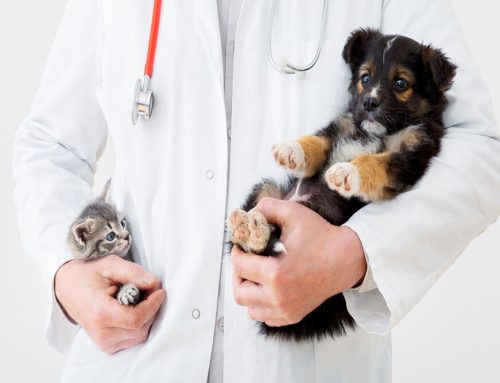Cancer is a concerning diagnosis and a common cause of death in senior cats and dogs. However, these conditions can be successfully treated, and your pet’s life can be prolonged and their quality of life improved when detected in the early stages. Our Providence Vet team wants to help by providing information about pet cancer and explaining potential warning signs.
Lymphoma in pets
Lymphoma is the most common cancer type in dogs and cats. The term “lymphoma” describes cancer that originates in lymphocytes, which are a type of white blood cell (WBC) that helps the immune system fight infection. The four types commonly found in pets include:
- Multicentric lymphoma — Multicentric lymphoma is the most common type in dogs and involves lymph nodes throughout the body.
- Alimentary lymphoma — Alimentary lymphoma targets the gastrointestinal tract, and is the most common type diagnosed in cats.
- Mediastinal lymphoma —Mediastinal lymphoma affects lymphoid organs in the chest, including the lymph nodes and thymus.
- Extranodal lymphoma — Extranodal lymphoma targets specific organs, such as the skin, eyes, kidney, lungs, or nervous system, outside the lymphatic system.
Cancers affecting dogs

Other cancers that commonly affect dogs include:
- Mast cell tumors — Mast cells are a type of WBC that play a role in the allergic response. When exposed to allergens, these cells release compounds called histamines that cause itchiness, sneezing, and ocular and nasal discharge. Mast cell tumors occur when mast cells rapidly divide and form a mass, and they most commonly form in the skin, but can also affect the spleen, liver, intestine, and bone marrow. Any dog breed can develop a mast cell tumor, but higher-risk breeds include boxers, bull terriers, Boston terriers, and Labrador retrievers.
- Hemangiosarcoma — Hemangiosarcomas are malignant growths that originate from the cells lining blood vessels. Since blood vessels are found throughout the body, these tumors can occur anywhere, but the skin, spleen, liver, and heart are the most common sites. Hemangiosarcomas tend to be locally aggressive and are highly likely to spread to other body areas. High-risk breeds include golden retrievers, German shepherds, and Labrador retrievers.
- Melanoma — Melanocytes are cells that produce melanin, and abnormal melanocyte production can result in a melanoma that can affect any body part, but most commonly the dog’s oral cavity. Melanomas are the most common malignant oral tumor found in dogs, with chow chows, schnauzers, and Scottish terriers at higher risk.
- Osteosarcoma — Osteosarcoma is the most common bone cancer that affects dogs. Tumors often start in the dog’s long limb bones, but can affect any bone. Osteosarcoma is typically aggressive, spreading rapidly throughout the body. Breeds at higher risk include large-breed dogs such as rottweilers and Irish wolfhounds.
Cancers affecting cats
Other cancers that commonly affect cats include:
- Squamous cell carcinoma (SCC) — SCC is a tumor arising from squamous cells, which are the cells that make up the outer skin layer. SCCs are precipitated by conditions such as physical trauma, sunlight exposure, and exposure to certain viruses. Common sites include the temples, outer ear edges, eyelids, lips, and the nose tip. Light coated cats are at higher risk.
- Mammary cancer — Mammary cancer develops when mammary tissue cells abnormally replicate. The majority of mammary tumors in cats are malignant, and are most commonly classified as adenocarcinomas. The female reproductive hormones (i.e., estrogen and progesterone) appear to play a role in mammary cancer development, so spaying a cat before her first heat cycle greatly reduces her mammary cancer risk. Siamese and Persian cats appear to be at higher risk.
- Fibrosarcoma — Fibrosarcomas arise from the cartilage, connective tissue, and fat under the cat’s skin. Most are extremely locally invasive, attacking the adjacent structures. Common sites include the oral cavity and vaccination injection sites. Feline leukemia virus-positive cats tend to be at increased risk.
Potential pet cancer warning signs
Early cancer detection improves your pet’s prognosis. While not all pets affected by cancer exhibit early warning signs, a veterinary professional should investigate the following:
- Abnormal lumps or bumps — Any new lump or swelling should be evaluated, since many cancers commonly manifest in this way. Check your pet regularly when grooming to ensure you detect new growths as soon as possible.
- Non-healing wounds — If your pet has a wound that is not healing despite appropriate care, our veterinary team should evaluate the area.
- Weight loss — Many cancer types result in weight loss, and a veterinary professional should evaluate your pet who has unexplained weight loss.
- Appetite loss — Appetite loss is another common sign, and your pet should be examined if they stop eating or lose their appetite.
- Bleeding or discharge — Bleeding or discharge from any body opening is a concerning sign that should be investigated.
- Foul odor — An unexplained foul odor emanating from your pet could signify cancer.
- Lethargy — If your typically energetic pet starts to sleep more and has difficulty exercising, they should be evaluated by a veterinary professional.
- Difficulty breathing, urinating, or defecating — Cancerous lesions affecting your pet’s respiratory system, urinary system, or digestive system may cause these signs.
- Lameness — Certain cancer types can cause lameness, which should be investigated.
Early detection is your pet’s best chance for effective cancer management. If your pet is exhibiting concerning signs, contact our Providence Vet team, so we can investigate the cause and determine an appropriate diagnostic and treatment plan.






Leave A Comment